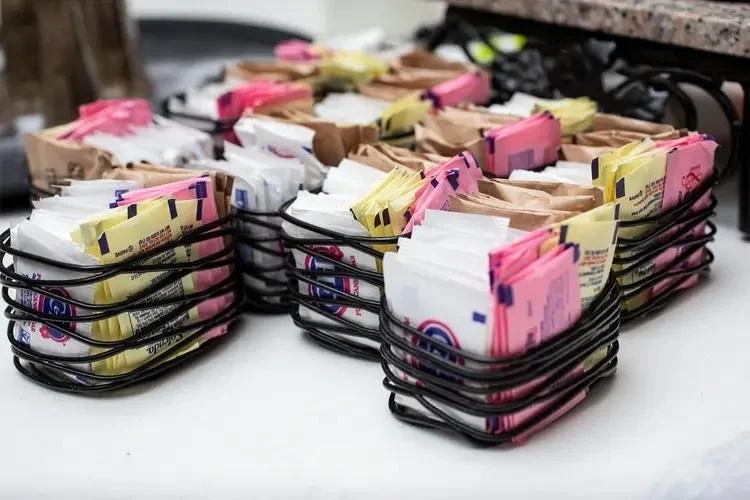On Having Your Cake and Eating it, Too
You didn’t really think I meant cake, did you?
Not today. I do believe there is a time and place for cake. It’s just not now.
Today I’m talking about artificial sweeteners — the ultimate attempt to get something for nothing.
Most hit the market in the ‘60s, ‘70s, and ‘80s with the promise of calorie-free indulgence. But, as we know, there’s no free lunch. Like everything that seems too good to be true, they were.
For your first clue as to why these sweeteners don’t belong on anyone’s shelf, here’s a quick history lesson….
Saccharin was the first one on the scene. It was accidentally discovered in 1879 by a chemist working on coal tar derivatives (let that sink in). It gained popularity because of sugar shortages in the World Wars, but then came under fire when it was linked to bladder cancer in lab rats. Those links were later debunked and saccharin was removed from the list of potential carcinogens. But, still, say it with me… coal tar.
This started a bizarre trend of artificial sweeteners being discovered unintentionally during chemical experiments.
Let’s hang on that word chemical for a second — because while everything is technically made of chemicals, I’m not talking about the ones found in nature. I’m talking about the ones cooked up in labs — the kind that come with a patent and a warning label. You know, like these:
Aspartame came along in 1965 (also by accident), got FDA approval in 1981, and is now found in everything from diet sodas to sugar-free gum. It has faced a lot of debate over concerns about headaches and other possible neurological effects in sensitive people, though evidence remains mixed. Anecdotally I can attest to that. When aspartame was first approved, marketers mailed gumball samples to consumers to generate buzz. Now, I was a kid who really liked gum. But I was also a kid with migraines. Within 10 minutes of putting the gum in my mouth, I had a massive headache. Looking back, the bigger concern is why I was allowed to eat something that randomly showed up in our mailbox. I’ll just say it was a different time.
Sucralose (aka Splenda) was discovered in 1976 when a scientist supposedly misheard his partner saying "test this chemical" as "taste this chemical." Yeah. Baffling. It’s about 600 times sweeter than sugar and is a common choice in baked goods.
Acesulfame Potassium (or Ace-K) entered the scene in the 1980s. It’s often blended with other sweeteners to enhance sweetness and mask aftertastes. Yum. It has a slightly bitter edge and is used in diet drinks, protein powders, and even pharmaceuticals.
Of this list, sucralose and aspartame are the widest used in the U.S. If a label says “sugar-free,” there’s a good chance at least one of them is inside.
This “GRAS” Isn’t Greener
So, what’s the big deal? After all, artificial sweeteners are classified as GRAS by the FDA – that means “generally recognized as safe.” Doesn’t that make them ok?
Let me ask you this.
Do you want your food to be for-the-most-part-as-far-as-we-know-we’re-pretty-sure safe or do you want it to be 100% straight-up safe?
Yeah, I choose that one.
The thing is, even though these sweeteners are low/no-calorie and considered ok to eat by the government, their impact on your health isn’t necessarily neutral.
Blood Sugar and Insulin Response
Believe it or not, some artificial sweeteners may still affect blood sugar and trigger an insulin response, the exact opposite of what you’d expect.Metabolic Confusion
Your brain senses sweetness but doesn’t get any calories. Over time, this disconnect may lead to increased sugar cravings and weight gain, though research is still ongoing.Gut Microbiome Disruption
Research has shown that sucralose and saccharin can damage the gut microbiome — and since the microbiome influences everything from digestion and blood sugar to immunity and even mood, that disruption could have ripple effects throughout the body.
Clean Alternatives
Instead of the lab-made stuff, consider these naturally-derived sweeteners:
Stevia
Made from the leaves of the stevia plant, this sweetener has been used for centuries in South America. It has zero calories, doesn’t spike blood sugar, and — bonus — may even help lower blood pressure, according to some early research. You still need to read the label though. Look for pure stevia without other additives.Monk Fruit
Never heard of a monk fruit? You’re not alone. This sweet melon-like fruit from Southeast Asia is relatively new in our parts. Monk fruit extract contains natural compounds that are intensely sweet but don’t impact blood sugar. It’s calorie-free, gut-friendly, and doesn’t carry the synthetic aftertaste of some artificial options.
One quick caution, though. Some products use monk fruit and/or stevia, but sneak some artificial sweeteners in there, too. Always read package labels!
Full disclosure, monk fruit extract is very sweet, which is not everyone's cup of tea. Stevia also has its critics, but I really like it. A combo of the two also works well.
The Tasty Takeaway
Using artificial sweeteners instead of sugar might seem like a no-brainer. But the potential long-term effects on metabolism, insulin sensitivity, and gut integrity should make you think twice. If you're aiming to cut back on sugar without compromising your health, natural options like stevia and monk fruit are cleaner, healthier ways to sweeten your day – no hidden consequences.
Of course, if your only choice is between real sugar and the synthetic stuff, I'm team sugar all the way.
Overwhelmed by hidden sugars and artificial sweeteners? Struggling to get processed food out of your diet and improve the way you eat? I’ll help you feel better, function better, and live better using a realistic, whole-foods approach customized to your needs. Click below to schedule a free session and learn more. It really is that easy. Sweet!
Until next time… eat well!


